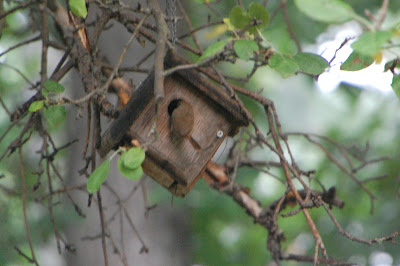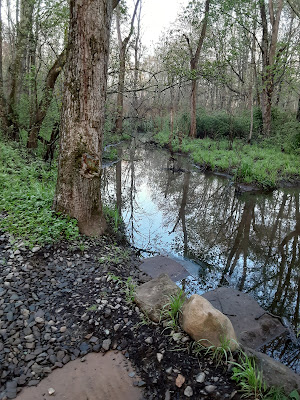One early morning, a female downy woodpecker, the smallest type found in the U.S., climbed up the dogwood tree as she has done for months. She looked over at the suet feeder hanging on the nearby pole. She calculated the distance as she prepared to fly over and expertly turn upside down to get at the suet. (The feeder is designed specifically for woodpeckers. See photo below.)
But on a recent May morning as she climbed the tree she found a small, wooden structure. As she came close to it, a small, brown bird flew out from the nearby bush and attacked her. She spread her wings to make herself look larger but the smaller bird was not put off. She left and he - for this was this year's house wren protecting the nest - returned, singing, to the bush.
 |
| From 2020: A female house wren checks to see if the coast is clear before leaving her young to get food. (Margo D. Beller) |
Shortly, the downy flew back, but to the bottom of the dogwood. She climbed a bit and recalculated her approach to the feeder. The house wren, meanwhile, flew to an upper branch near the nest box and sang. The downy came to eat at the suet feeder but soon flew off.
Watching the wrens from my screened porch is my usual morning entertainment. When I last wrote, the two wrens had put in enough twigs for the nest and were flying in the yard looking for food. Every so often the female would go into the box and the male would sing nearby.
Then I went away for a few days. When I returned, things had changed.
In the first couple of days after I returned the female would be in the box most of the time, only coming out to eat. The male would usually fly close to the box and sing. Maybe he was telling her the coast was clear? I don't know, but she would go out for a time and then go back in. The male would sing from the nearby bush. He did not go into the nest box.
 |
| Downy woodpecker demonstrating how it hangs beneath the suet feeder. (Margo D. Beller) |
Then I saw something interesting one recent morning - the female flew out of the box holding a big blob of poop. That could only mean one thing: The eggs had hatched and now there were young to brood, feed and clean up after. So I wasn't surprised to see the female now making more frequent trips out of the box. The male did not participate in the feeding but I know from past years the two adults should soon be shuttling back and forth to feed the young, which will have grown to fill the box.
For now, however, both parents are defending their young. If another type of bird is in the dogwood and comes too close to the nest, as the downy did, the wren behavior becomes more aggressive.
I am not an ornithologist. I only know what I observe. And it seems to me the wrens' behavior is different depending on the size of the other type of bird and whether that bird has a long, pointy beak.
So a downy or other type of woodpecker would be chased off because it could, if it wanted, put its beak in and grab a young wren with its long tongue. However, a cardinal, with its stout, seed-cracking beak, didn't seem to be a threat. (The pair I saw one morning that flew to a branch were more interested in that bonding activity known as "the kiss.") A smaller finch, such as a goldfinch or house finch, gets chased off even though they are seed eaters.
However, a blue jay or its cousin the crow would definitely not be welcomed. (Years ago I saw a jay snatch a young wren that had fallen to the ground.) Neither would squirrels.
 |
| A blue jay is a predator of baby birds such as house wrens. (Margo D. Beller) |
Another unwelcome bird is the all-too-common house sparrow. These birds don't want to eat baby wrens but they have been known to pull out the young and take the nest for themselves. When house sparrows flew to the dogwood one morning the male wren flew at them while the female came out of the box and blocked the opening. When the sparrows refused to leave I came outside and they took off. I'm not sure if the wrens appreciated my help but the female went back into the box while the male sang from the nearby bush.
I reckon that sometime in the next week the food shuttling will begin. In the meantime, I've removed the feeders that hung closest to the dogwood. It is getting to that point where the birds will want protein from insects more than they'll need fat from sunflower seeds. Plus they'll have to take insects back to their own young. I still have one feeder out for the birds but that will soon be inside for the summer, too.








